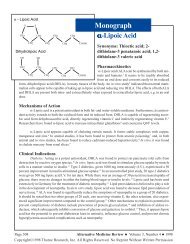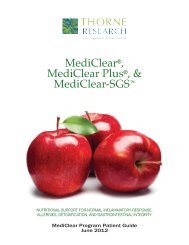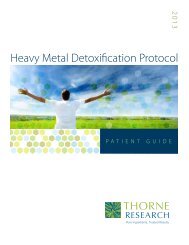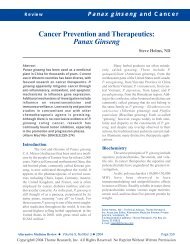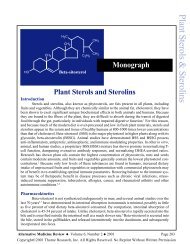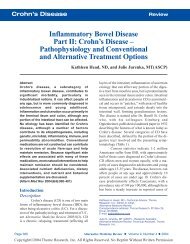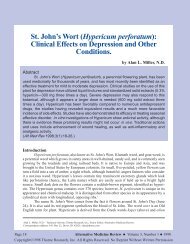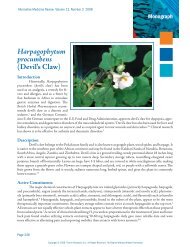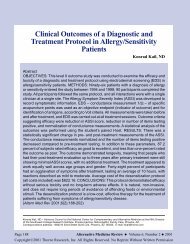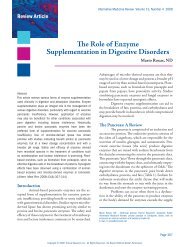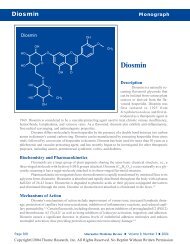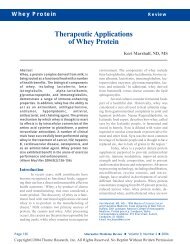Green Tea Monograph - Thorne Research
Green Tea Monograph - Thorne Research
Green Tea Monograph - Thorne Research
Create successful ePaper yourself
Turn your PDF publications into a flip-book with our unique Google optimized e-Paper software.
OH<br />
OH<br />
OH<br />
OH<br />
HO<br />
O<br />
HO<br />
O<br />
OH<br />
OH<br />
H H<br />
Epicatechin<br />
OH<br />
H H<br />
OH<br />
OH<br />
Epigallocatechin (EGC)<br />
OH<br />
OH<br />
<strong>Monograph</strong><br />
COOH<br />
HO<br />
H<br />
O<br />
OH<br />
OH<br />
<strong>Green</strong> <strong>Tea</strong><br />
HO<br />
OH<br />
H<br />
O<br />
C<br />
OH<br />
O<br />
OH<br />
OH<br />
Description and Constituents<br />
Gallic Acid<br />
Epigallocatechin gallate (EGCG)<br />
<strong>Tea</strong> is one of the most widely consumed<br />
beverages in the world today, second<br />
only to water, and its medicinal properties<br />
have been widely explored. The tea<br />
plant, Camellia sinensis, is a member of the Theaceae family, and black, oolong, and green tea are<br />
produced from its leaves. It is an evergreen shrub or tree and can grow to heights of 30 feet, but is<br />
usually pruned to 2-5 feet for cultivation. The leaves are dark green, alternate and oval, with serrated<br />
edges, and the blossoms are white, fragrant, and appear in clusters or singly. Unlike black and oolong<br />
tea, green tea production does not involve oxidation of young tea leaves. <strong>Green</strong> tea is produced from<br />
steaming fresh leaves at high temperatures, thereby inactivating the oxidizing enzymes and leaving the<br />
polyphenol content intact. The polyphenols found in tea are more commonly known as flavanols or<br />
catechins and comprise 30-40 percent of the extractable solids of dried green tea leaves. The main<br />
catechins in green tea are epicatechin, epicatechin-3-gallate, epigallocatechin, and epigallocatechin-3-<br />
gallate (EGCG), with the latter being the highest in concentration. <strong>Green</strong> tea polyphenols have demonstrated<br />
significant antioxidant, anticarcinogenic, anti-inflammatory, thermogenic, probiotic, and antimicrobial<br />
properties in numerous human, animal, and in vitro studies. 1,2<br />
Mechanisms of Action<br />
The anticarcinogenic properties of green tea polyphenols, mainly EGCG, are likely a result of<br />
inhibition of biochemical markers of tumor initiation and promotion, induction of apoptosis, and inhibition<br />
of cell replication rates, thus retarding the growth and development of neoplasms. 3,4 Their antioxidant<br />
potential is directly related to the combination of aromatic rings and hydroxyl groups that<br />
make up their structure, and is a result of binding and neutralization of free radicals by the hydroxyl<br />
groups. In addition, green tea polyphenols stimulate the activity of hepatic detoxification enzymes,<br />
thereby promoting detoxification of xenobiotic compounds, and are also capable of chelating metal<br />
ions, such as iron, that can generate radical oxygen species. 5,6<br />
<strong>Green</strong> tea polyphenols inhibit the production of arachidonic acid metabolites such as pro-inflammatory<br />
prostaglandins and leukotrienes, resulting in a decreased inflammatory response. Human<br />
and animal studies have demonstrated EGCG’s ability to block inflammatory responses to ultraviolet A<br />
and B radiation as well as significantly inhibiting the neutrophil migration that occurs during the inflammatory<br />
process. 7-9<br />
<strong>Research</strong> on green tea’s thermogenic properties indicates a synergistic interaction between its<br />
caffeine content and catechin polyphenols may result in prolonged stimulation of thermogenesis. Studies<br />
OH<br />
Page 372 Alternative Medicine Review ◆ Volume 5, Number 2 ◆ 2000<br />
Copyright©2000 <strong>Thorne</strong> <strong>Research</strong>, Inc. All Rights Reserved. No Reprint Without Written Permission
Terminalia arjuna<br />
have also shown green tea extracts are capable of reducing fat digestion by inhibiting digestive<br />
enzymes. 10,11 Although the exact mechanism is unknown, green tea catechins have been shown to<br />
significantly raise levels of Lactobacilli and Bifidobacteria while decreasing levels of numerous potential<br />
pathogens. 12 Studies have also demonstrated green tea’s antibacterial properties against a variety of<br />
gram-positive and gram-negative species. 13<br />
Clinical Indications<br />
Cancer Prevention/Inhibition<br />
Several studies have demonstrated green tea polyphenols’ preventative and inhibitory effects<br />
against tumor formation and growth. While the studies are not conclusive, green tea polyphenols, particularly<br />
EGCG, may be effective in preventing cancer of the prostate, breast, esophagus, stomach,<br />
pancreas, and colon. 14 There is also some evidence that green tea polyphenols may be chemopreventative<br />
or inhibitory toward lung, skin, and liver cancer, 15-17 bladder and ovarian tumors, 18,19 leukemia, 20 and<br />
oral leukoplakia. 21<br />
Antioxidant Applications<br />
Many chronic disease states and inflammatory conditions are a result of oxidative stress and<br />
subsequent generation of free radicals. Some of these include heart disease (resulting from LDL oxidation),<br />
renal disease and failure, several types of cancer, skin exposure damage caused by ultraviolet (A<br />
and B) rays, as well as diseases associated with aging. <strong>Green</strong> tea polyphenols are potent free radical<br />
scavengers due to the hydroxyl groups in their chemical structure. The hydroxyl groups can form<br />
complexes with free radicals and neutralize them, preventing the progression of the disease process. 22<br />
Obesity/Weight Control<br />
Recent studies on green tea’s thermogenic properties have demonstrated a synergistic interaction<br />
between caffeine and catechin polyphenols that appears to prolong sympathetic stimulation of<br />
thermogenesis. A human study of green tea extract containing 90 mg EGCG taken three times daily<br />
concluded that men taking the extract burned 266 more calories per day than did those in the placebo<br />
group and that green tea extract’s thermogenic effects may play a role in controlling obesity. 23 <strong>Green</strong><br />
tea polyphenols have also beeen shown to markedly inhibit digestive lipases in vitro, resulting in decreased<br />
lipolysis of triglycerides, which may translate to reduced fat digestion in humans. 10,11<br />
Intestinal Dysbiosis and Infection<br />
A small study in Japan demonstrated a special green tea catechin preparation (30.5% EGCG)<br />
was able to positively affect intestinal dysbiosis in nursing home patients by raising levels of Lactobacilli<br />
and Bifidobacteria while lowering levels of Enterobacteriaceae, Bacteroidaceae, and eubacteria.<br />
Levels of pathogenic bacterial metabolites were also decreased. 12 An in vitro study also demonstrated<br />
green tea’s antimicrobial activity against a variety of gram-positive and gram-negative pathogenic<br />
bacteria that cause cystitis, pyelonephritis, diarrhea, dental caries, 24 pneumonia, and skin infections. 13<br />
Other Applications<br />
Sickle cell anemia is characterized by a population of “dense cells” that may trigger vasoocclusion<br />
and the painful sickle cell “crisis.” One study demonstrated that 0.13 mg/mL green tea extract<br />
was capable of inhibiting dense-cell formation by 50 percent. 25<br />
Alternative Medicine Review ◆ Volume 5, Number 2 ◆ 2000 Page 373<br />
Copyright©2000 <strong>Thorne</strong> <strong>Research</strong>, Inc. All Rights Reserved. No Reprint Without Written Permission
Another potential therapeutic application of green tea is the treatment of psoriasis. The combination<br />
therapy of psoralens and ultraviolet A radiation is highly effective but has unfortunately been<br />
shown to substantially increase the risk for developing squamous cell carcinoma and melanoma. An in<br />
vitro study using human and mouse skin demonstrated that pre- and post-treatment with green tea<br />
extract inhibited DNA damage induced by the psoralen/ultraviolet A radiation exposure. 8<br />
Dosage and Toxicity<br />
<strong>Green</strong> tea is generally considered a safe, non-toxic beverage and consumption is usually without<br />
side-effects. The average cup of green tea, however, contains from 10-50 mg of caffeine and overconsumption<br />
may cause irritability, insomnia, nervousness, and tachycardia. Because studies on its<br />
possible teratogenic effect are inconclusive, caffeine consumption is contraindicated during pregnancy.<br />
Lactating women should also limit caffeine intake to avoid sleep disorders in infants. 26<br />
The dosage for green tea beverage varies, depending on the clinical situation and desired therapeutic<br />
effect. The phenolic content of green tea infusion is between 50-100 mg polyphenols per cup,<br />
depending on species, harvesting variables, and brewing methods, 27 with typical dosages ranging from<br />
3 to 10 cups per day. Cancer preventative effects are usually associated with dosages in the higher end<br />
of the range. 28 <strong>Green</strong> tea extracts standardized to 80-percent total polyphenols are dosed at an average<br />
of 500-1500 mg per day.<br />
References<br />
1. Alschuler L. Grean <strong>Tea</strong>: Healing tonic. Am J Natur Med 1998;5:28-31.<br />
2. Graham HN. <strong>Green</strong> tea composition, consumption, and polyphenol chemistry. Prev Med 1992;21:334-350.<br />
3. Nihal A, Hasan M. <strong>Green</strong> tea polyphenols and cancer: biological mechanisms and practical implications. Nutr Rev<br />
1999;57:78-83.<br />
4. Ahmad N, Feyes DK, Nieminen AL, et al. <strong>Green</strong> tea constituent epigallacatechin-3-gallate and induction of<br />
apoptosis and cell cycle arrest in human carcinoma cells. J Natl Cancer Inst 1997;89:1881-1886.<br />
5. Serafini M, Ghiselli A, Ferro-Luzzi A. In vivo antioxidant effect of green and black tea in man. Eur J Clin Nutr<br />
1996;50:28-32.<br />
6. Erba D, Riso P, Colombo A, Testolin G. Supplementation of Jurkat T cells with green tea extract decreases<br />
oxidative damage due to iron treatment. J Nutr 1999;129:2130-2134.<br />
7. Katiyar SK, Matsui MS, Elmets CA, Mukhtar H. Polyphenolic antioxidant (-)-epigallocatechin-3-gallate from<br />
green tea reduces UVB-induced inflammatory responses and infiltration of leukocytes in human skin. Photochem<br />
Photobiol 1999;69:148-153.<br />
8. Zhao JF, Zhang YJ, Jin XH, et al. <strong>Green</strong> tea protects against psoralen plus ultraviolet A-induced photochemical<br />
damage to skin. J Invest Dermatol 1999;113:1070-1075.<br />
9. Hofbauer R, Frass M, Gmeiner B, et al. The green tea extract epigallocatechin gallate is able to reduce neutrophil<br />
transmigration through monolayers of endothelial cells. Wien Klin Wochenschr 1999;111:276-282.<br />
10. Dulloo AG, Seydoux J, Girardier L, et al. <strong>Green</strong> tea and thermogenesis: interactions between catechin-polyphenols,<br />
caffeine, and sympathetic activity. Int J Obes Relat Metab Disord 2000;24:252-258.<br />
11. J uhel C, Armand M, Pafumi Y, et al. <strong>Green</strong> tea extract (AR25) inhibits lipolysis of triglycerides in gastric and<br />
duodenal medium in vitro. J Nutr Biochem 2000;11:45-51.<br />
12. Goto K, Kanaya S, Nishikawa T, et al. <strong>Green</strong> tea catechins improve gut flora. Ann Long-Term Care 1998;6:1-7.<br />
13. Chou CC, Lin LL, Chung KT. Antimicrobial activity of tea as affected by the degree of fermentation and manufacturing<br />
season. Int J Food Microbiol 1999;48:125-130.<br />
14. Katiyar SK, Mukhtar H. <strong>Tea</strong> antioxidants in cancer chemoprevention. J Cell Biochem 1997;27:S59-S67.<br />
Page 374 Alternative Medicine Review ◆ Volume 5, Number 2 ◆ 2000<br />
Copyright©2000 <strong>Thorne</strong> <strong>Research</strong>, Inc. All Rights Reserved. No Reprint Without Written Permission
Terminalia arjuna<br />
15. Lee IP, Kim YH, Kang MH, et al. Chemopreventative effect of green tea (Camellia sinensis) against cigarette<br />
smoke-induced mutations (SCE) in humans. J Cell Biochem 1997;27:S68-S75.<br />
16. Picard D. The biochemistry of green tea polyphenols and their potential application in human skin cancer. Altern<br />
Med Rev 1996;1:31-42.<br />
17. Hirose M, Hoshiya T, Akagi K, et al. Effects of green tea catechins in a rat multi-organ carcinogenesis model.<br />
Carcinogenesis 1993;14:1549-1553.<br />
18. Sato D. Inhibition of urinary bladder tumors induced by N-butyl-N-(4-hydroxybutyl)-nitrosamine in rats by green<br />
tea. Int J Urol 1999;6:93-99.<br />
19. Sugiyama T, Sadzuka Y. Enhancing effects of green tea components on the antitumor activity of adriamycin<br />
against M5076 ovarian sarcoma. Cancer Lett 1998;133:19-26.<br />
20. Otsuka T, Ogo T, Eto T, et al. Growth inhibition of leukemic cells by (-)-epigallocatechin gallate, the main<br />
constituent of green tea. Life Sci 1998;63:1387-1403.<br />
21. Khafif A, Schantz SP, al-Rawi M, et al. <strong>Green</strong> tea regulates cell cycle progression in oral leukoplakia. Head Neck<br />
1998;20:528-534.<br />
22. Ichihashi M, Ahmed NU, Budiyanto A, et al. Preventive effect of antioxidant on ultraviolet-induced skin cancer in<br />
mice. J Dermatol Sci 2000;23:S45-S50.<br />
23. Dulloo AG, Duret C, Rohrer D, et al. Efficacy of a green tea extract rich in catechin polyphenols and caffeine in<br />
increasing 24-h energy expenditure and fat oxidation in humans. Am J Clin Nutrition 1999;70:1040-1045.<br />
24. You S. Study on feasibility of Chinese green tea polyphenols (CTP) for preventing dental caries. Chung Hua Kou<br />
Hsueh Tsa Chih 1993;28:197-199.<br />
25. Ohnishi ST, Ohnishi T, Ogunmola GB. Sickle cell anemia: a potential nutritional approach for a molecular<br />
disease. Nutrition 2000;16:330-338.<br />
26. DerMarderosian A. The Review of Natural Products. St. Louis, MO: Facts and Comparisons, Wolters Kluwer Co.<br />
1999.<br />
27. Yamimoto T, Juneja LR, Djoing-Chu C, Kim M. Chemistry and Applications of <strong>Green</strong> <strong>Tea</strong>. Boca Raton, FL: CRC<br />
Press, 1997: 51-52,<br />
28. Imai K, Suga K, Nakachi K. Cancer-preventative effects of drinking tea among a Japanese population. Prev Med<br />
1997;26:769-775.<br />
Alternative Medicine Review ◆ Volume 5, Number 2 ◆ 2000 Page 375<br />
Copyright©2000 <strong>Thorne</strong> <strong>Research</strong>, Inc. All Rights Reserved. No Reprint Without Written Permission



